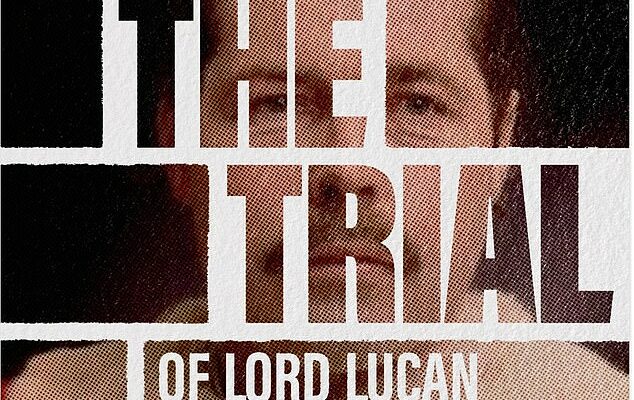This is the sensational, never-before-seen Scotland Yard report from almost 50 years ago that finally reveals the definitive account of the Lord Lucan mystery.
The newly discovered, previously confidential 60-page document chronicles in astonishing detail the Crown’s case against the missing peer, suspected of bludgeoning his children’s nanny Sandra Rivett to death with a lead pipe and then trying to kill his estranged wife in one of Britain’s most notorious crime cases. It also lays bare how his powerful friends threw up a wall of silence to protect him.
It will be the basis for a world exclusive Mail true crime podcast, The Trial of Lord Lucan, which begins today and will run from Monday, June 3, to Friday, June 7, with a new episode each day.
The podcast unpicks the truth about the case – with an unmissable twist for true crime fans which turns YOU into the jury. Two real-life eminent barristers will stage a mock trial and argue whether Lord Lucan was innocent or guilty using the bombshell dossier, witness interviews, letters, and other evidence – before listeners are asked to vote on Mail Online if they think the peer is innocent or guilty.
READ THE BOMBSHELL LUCAN REPORT BELOW. LISTEN TO THE PODCAST HERE
The Trial of Lord Lucan: Follow The Mail’s brand new podcast wherever you get your podcasts
Metropolitan Police Cannon Row Police Station ‘A’ Divn
Re The Murder of Sandra Rivett and the Attempted Murder of the Countess of Lucan
To: Commander, ‘A’ Division
This report deals with the murder of Sandra Rivett, 29, a children’s nurse, and the attempted murder of Lady Veronica Lucan, 37, at 46, Lower Belgrave Street, London SW1, on November 7, 1974 by the Earl of Lucan.
On November 12, 1974, successful application was made at Bow Street Magistrates’ Court for warrants to arrest Lord Lucan — Richard John Bingham — for these offences, but to date, he has not been apprehended. No difficulty has been experienced when dealing with witnesses connected with Sandra Rivett. However, the same cannot be said for other persons encountered who, in the main, are members of the International Socialite set and friends or acquaintances of Lord and Lady Lucan. While being outwardly obstructive, they have been reluctant to assist police.
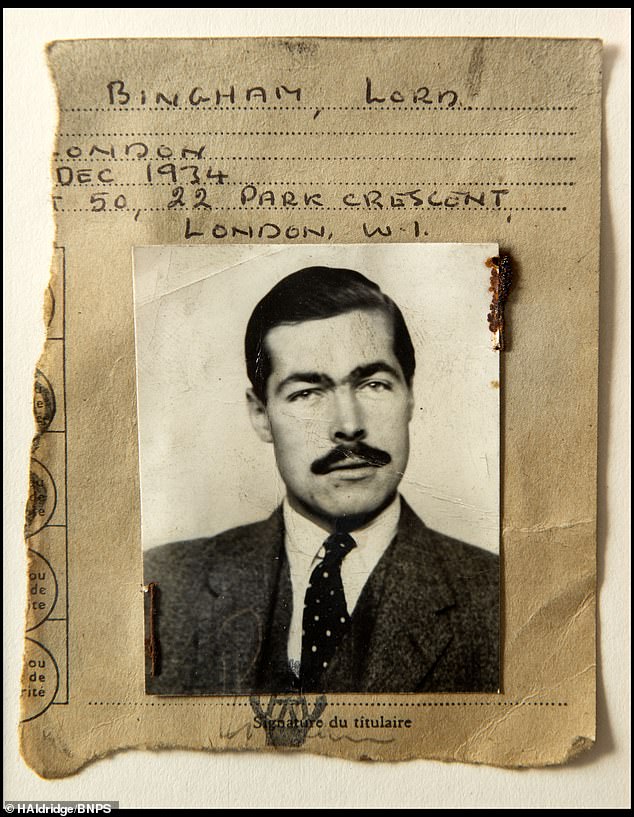
Lord Lucan’s AA membership card, which he left behind before driving off and disappearing
From an early stage it was known that private detectives have been employed by Lord Lucan’s friends to enquire into the background and boyfriends of [Sandra Rivett] and to discredit the evidence of Lady Lucan. It is also believed that a barrister has been retained by these friends to represent the Earl.
Such is the nature of this bizarre crime, it is felt necessary to explain the background of the three principal characters.
Sandra Rivett (nee Hensby)
One of four daughters, born on September 16, 1945, to Albert Hensby and Eunice Hensby at Basingstoke, Hampshire. From a working-class background, she attended a secondary modern school at Caterham, Surrey, leaving in 1959, aged 14. She worked as an apprentice hairdresser and factory worker until, aged 18, she became a voluntary patient, for three months, at Redhill Mental Hospital, suffering from depression.
While at this hospital she met a John Andrews and gave birth to a son, Stephen, on March 13 1964, at Mayday Hospital, Croydon. This child was legally adopted by her parents. She then worked as a nanny and as a nurse in an old people’s home. In 1966 she went to Portsmouth where she met and, on June 16 1967, married Roger Rivett, a regular sailor in the Royal Navy. This marriage was not a success and they finally parted in May 1974.
During the marriage, Sandra Rivett worked in a factory, as a home help and companion, and, after her marriage broke up, looked after an elderly couple in London. On August 26 1974, she obtained employment as Nanny with Lady Lucan. She liked this work, got on well with Lady Lucan and was loved by the children.

Nanny Sandra Rivett was bludgeoned to death
Lady Lucan
The Countess of Lucan was born May 3, 1934, Veronica Mary Duncan, the daughter of an Army Major into a middle-class background. In 1956, aged 17, she and her sister, Christina, shared a flat in London and began to mix with members of London society. In 1963, Christina married amateur jockey and racehorse owner, William Shand-Kydd. It was through her sister that, later that year, Veronica met and married Lord Richard John Bingham. Six weeks after this marriage, her husband succeeded to the Earldom and became Lord Lucan.
- In July 1964 they bought the lease of 46, Lower Belgrave Street, London SW1, a five-storey, Victorian, terraced house. At first the marriage was happy, and three children were born: Lady Frances, 10, Lord George, 7, and Lady Camilla, 4.
- After the birth of her son, Lady Lucan suffered from post-natal depression. This was increased after the difficult third pregnancy and the constant friction between the couple. If the numerous witnesses in this case are to be believed, Lady Lucan is bordering on insanity. However, from my impressions, although a difficult and highly-strung woman, she is truthful and will make an excellent witness.
Lord Lucan
Richard John Bingham, 40, 18 December, 1934, was the eldest son of the late VI Earl of Lucan and his wife, Lady Kaitlin Lucan. He attended Eton College. From 1953 – 55, he was inducted in National Service with the Grenadier Guards, attaining the rank of Lieutenant. He then worked for a firm of Merchant Bankers in the City, leaving after he did not advance as he expected.
Lord Lucan became increasingly involved as a gambler and was never again gainfully employed. He was associated with illegal gambling houses in Belgravia and Mayfair until gambling was legalised in 1964, when he became a founder member of the Clermont Club, Berkeley Square, London W1.
He was known as ‘Lucky’, a nickname to a losing streak rather than a winning one. During this period, he was bobsleighing, power boat racing and owned several racehorses. He is described as a typical Edwardian aristocrat both in manner and dress.
MATRIMONIAL BACKGROUND OF THE LUCAN FAMILY
On January 7 1973, Lord Lucan left the marital home and moved to a nearby flat at 72A Elizabeth Street, London SW1, which he leased. There was much bitterness between Lord and Lady Lucan, and on March 23 1973, whilst the children were in Green Park with their Nanny, they were seized by Lord Lucan, assisted by two men, and the Nanny handed a court order for Lady Lucan.
After a bitterly fought High Court case, on June 22 1973 Lady Lucan was granted custody of the children. Lord Lucan was allowed access every other weekend and during half the school holidays. This unhappy situation prevailed throughout 1973/74.
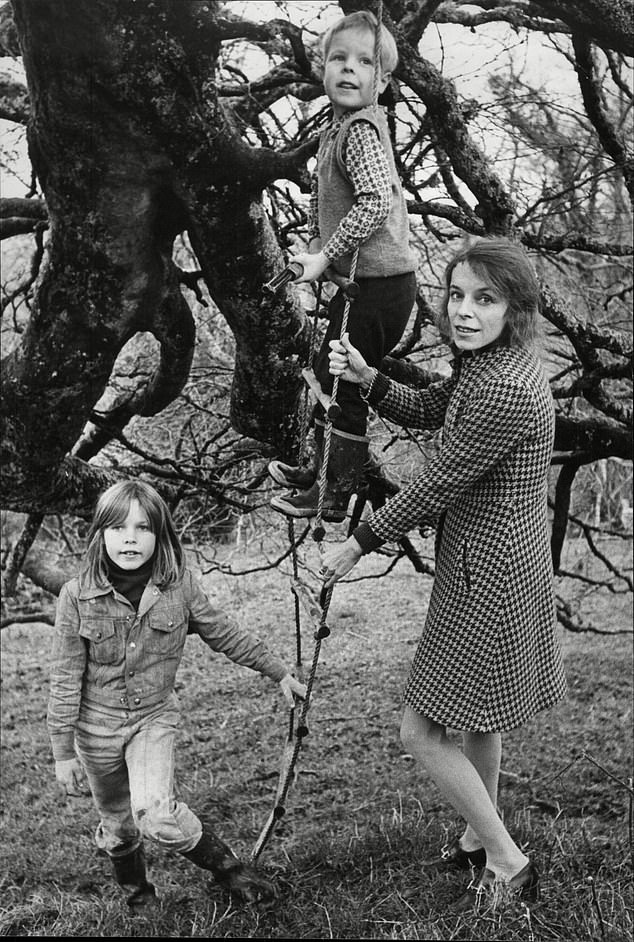
Lady Lucan with Frances and George, two of her three children with Lord Lucan
DESCRIPTION OF THE INCIDENT
On the evening of Thursday November 7 ,1974, at about 8.55pm, Lady Lucan was in her second-floor bedroom watching the television with Lady Frances, the other children having been put to bed by Sandra Rivett.
Mrs Rivett returned to Lady Lucan’s bedroom and enquired if she would like a cup of tea. As the answer was in the affirmative, it is believed she collected some dirty cups and saucers and left to go to the basement kitchen.
Lady Lucan and her daughter continued watching television until about 9.15pm, when, as Mrs Rivett had not returned, Lady Lucan went to enquire as to the delay.
On reaching the top of the stairs leading to the basement kitchen she was surprised to see there were no lights in the basement and called out ‘Sandra, Sandra’.
It was at this moment that she heard a noise from the ante room leading to the cloakroom on the same floor and was struck several heavy blows on the head… She fell to the ground and started to scream. Her assailant stuck his fingers down her throat and told her to ‘Shut up’.
She felt he was wearing gloves. It was then Lady Lucan realised that her husband was the attacker. She bit his gloved fingers, and he turned her over on her back and put his hands around her throat. A struggle ensued, [during] which she grabbed his genitalia.
Lord Lucan seemed to lose his strength and Lady Lucan began desperately talking. There was a conversation, during which he admitted killing Sandra. She convinced her husband they should retire to her bedroom to wash her wounds…When they reached the bedroom, Lady Lucan told her daughter Frances, who was still watching television, to go to bed, which she did.
Lord Lucan switched off the television, placed a towel on the pillow and Lady Lucan laid down on the bed. When he went to the adjoining bathroom, she seized this opportunity and fled to the Plumbers Arms public house nearby and collapsed in the bar. Police and ambulance were called and to the first officers on the scene, she hysterically screamed ‘He’s killed our Nanny’. They managed to elicit her address and she was removed to St George’s Hospital, Hyde Park Corner, SW1.
Police attended 46, Lower Belgrave Street, forced the front door and searched the house. In the basement room they found a large canvas sack, containing the body of Sandra Rivett. A great deal of blood was splattered on the walls, floor, and stair carpet. The children were found safe in their bedrooms on the top floor.
The evidence of all persons in this case will be discussed at a later stage but I intend now, under various headings, to deal factually and chronologically with the events.
INITIAL ENQUIRIES
Numerous uniform officers attended the scene and they, in turn, called upon the CID, resulting in Det Sgt Forsyth, DC Morgan and DC Stewart of Gerald Road Police Station [Mayfair] attending to set in motion the murder inquiry. Det Sgt Forsyth and DC Stewart went to 5, Eaton Row, SW1, a five-bedroomed flat, forced entry and searched, unsuccessfully, for Lord Lucan who had the lease of both properties.
Dr Michael Smith, Division Surgeon, attended at 10.45pm and certified that Sandra Rivett was dead.
At 1am on November 8 1974, I attended the scene with DCI Gerring and took up the enquiry.
An examination of the premises was made, and a pictorial record taken by Senior Photographer Chilton.
Senior Fingerprint Officer Lucas of New Scotland Yard attended and his statement will be discussed under the heading ‘Forensic Evidence’.

The 7th Earl of Lucan with soon-to-be wife Veronica in their official engagement picture from 1963
Here I will highlight certain objects and matters of importance found and recorded by Exhibits Officer, DC Morgan:
The murder weapon: an 8-10in-piece of lead piping, bound with adhesive tape, was found on the ground floor in the ante room leading to the rear cloakroom.
The house was very poorly lit and numerous switches, fittings and/or bulbs were defective on the ground floor and in the basement.
There appeared to be two separate seats of attack: one in the small well of the stairs on the ground floor, adjacent to the basement. Here the carpet was heavily soaked with blood and there were directional splashes of blood on the wall and ceiling. There were also heavy smears of blood on the side walls of the passageway in this area. The base of the basement door and the wall of the basement staircases were splattered and smeared with blood.
The second seat of the attack was confined to the breakfast room in the basement, near to where the body of Sandra Rivett was found. There were pools of blood at the foot of the stairs around the sack containing her body, and in front of and to the side of the piano and directional blood splashes were on the wall behind the piano.
There was no sign of forcible entry or exit of any window or door.
There was hair, and blood stains, on the hand basin in the ground floor rear cloakroom and on the heater above.
‘An 8 to 10in piece of lead pipe, bound with adhesive tape, was found on the ground floor… There was a blood-stained towel on Lady Lucan’s pillow’
There was a blood-stained towel on the pillow of what appears to be Lady Lucan’s bed.
The body of Sandra Rivett had been placed in a canvas bag which suggested the intention of removing the body from the scene. This bag on examination was found to be a United States mail bag.
At this stage I was aware that Lord Lucan had [made] two telephone calls to his mother, the Dowager Lady Lucan, since the murder. The first, at about 10.45pm, told her that a catastrophe had occurred at 46, Lower Belgrave Street, that some other person had been involved and that the Nanny and his wife had been injured.
He requested that his mother attend and take care of the three children. She did as he requested and accompanied the children back to her home in St John’s Wood in the company of PC Baddick. This officer was present at 12.30am on November 8 1974 when she again spoke to her son who, after satisfying himself the children were safe and told by his mother that the police wished to see him, stated that he’d contact them later that morning.
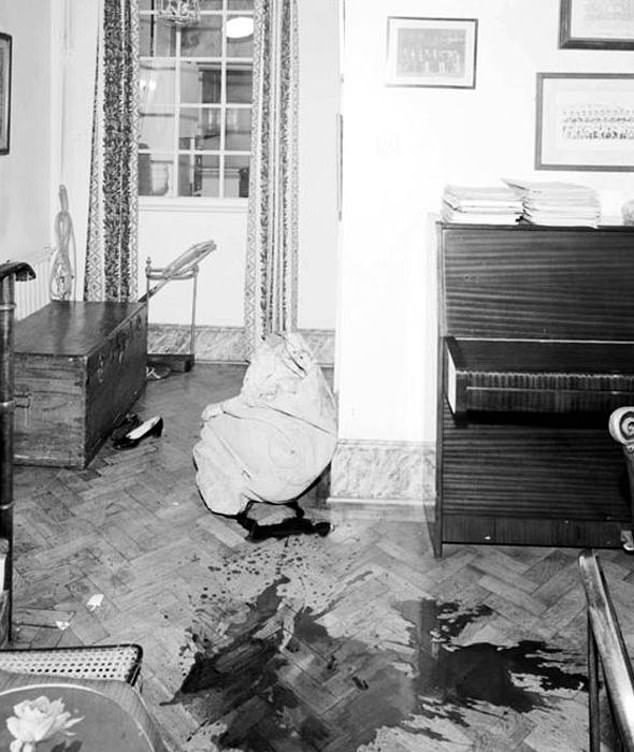
The blood-soaked basement with Sandra Rivett’s body inside a mail sack beside a cast-off shoe
At 1.30am, DCI Gerring and I attended St George’s Hospital where in a comatosed state and suffering from severe head injuries, I saw Lady Lucan but was unable to interview her… I thought it advisable to have her injuries photographed prior to her receiving treatment.
The doctor and nurses who attended Lady Lucan on admission, related her garbled ramblings in which she said that her husband had killed the Nanny and was responsible for her injuries.
DCI Gerring and I returned to the scene and arranged the removal of the body. Forensic officers remained. Guards were placed at the scene, at 72A Elizabeth Street [where Lucan lived] and 5, Eaton Row [Lucan held the lease], in the hope that Lord Lucan would return to one of those addresses.
POST-MORTEM EXAMINATION ON NOVEMBER 8, 1974, UPON SANDRA RIVETT
This examination was conducted by Professor Keith Simpson at Westminster Mortuary, Horseferry Road, London SW1, commencing at 9.30am. Present were myself [and four colleagues and a photographer from New Scotland Yard]. Prof Simpson was shown the piece of lead pipe which he weighed and examined.
The injuries to Sandra Rivett’s head and the bruising to her shoulders, arms, and hands were photographed. The cause of death was given as ‘blunt head injuries’. The pathologist said the weapon found at the scene could have caused these injuries.
IDENTIFICATION OF SANDRA RIVETT
At 2.40pm on Friday November 8 1974, Mr Roger Rivett, the estranged husband of the dead woman, identified her body.
A full-scale murder office was set up at Gerald Road Police Station. When Lord Lucan failed to contact the police, his image was circulated as ‘Wanted for Interview’.
Later that evening, I saw Lady Lucan in St George’s Hospital and she gave a detailed account of the previous evening [due to the strain of the ordeal, her witness statement was completed the following day].
On November 9, the forensic examination of the murder scene was ongoing.
The same day Lord Lucan’s brother-in-law, Mr William Shand-Kydd, attended Gerald Road Police Station with two letters written to him by Lord Lucan. The letters bore an Uckfield, Sussex, postmark – dated November 8, 1974, and Mr Shand-Kydd explained that the letters had been written by Lord Lucan at the home of Mr Ian Maxwell-Scott, a mutual friend to whose home Lord Lucan had gone shortly after the murder.
Broadly, the contents of these letters were to the effect that Lord Lucan had interrupted a fight at Lower Belgrave Street and after the man had left, his wife had accused him of having hired the man. He said he took her upstairs and after sending his daughter, Frances, to bed, had tried to clean up his wife but she left the house while he was in the bathroom.
He went on to say that his wife would say he had done it. He said his main concern was his children and that he would lie ‘doggo’ for a time. He asked his brother-in-law to look after the children with financial assistance from Coutts Bank. He describes his wife’s hatred for him and the desire that his children should not go through life knowing their father had stood in the dock for attempted murder and when they were old enough would he explain to them the ‘dream of paranoia’.
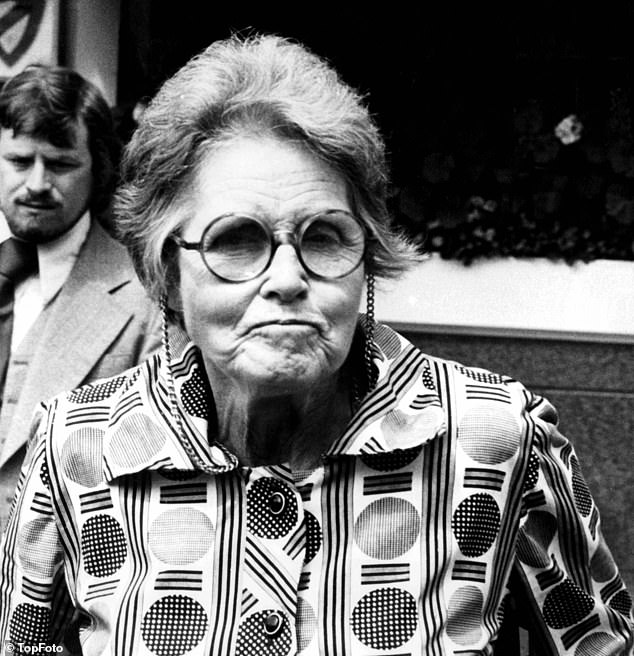
The Dowager Lady Lucan attends the inquest of Sandra Rivett
The second letter is headed ‘Financial Matters’ and asks that the proceeds of an auction sale at Christies be used to pay off various bank overdrafts and that other creditors would have to wait.
These letters were written in the past tense and considerable importance was attached to them. An officer was despatched to interview Susan Maxwell-Scott, wife of Ian Maxwell-Scott.
She related how Lord Lucan had called at her address at about 11.30pm on November 7. On being told her husband was in London, she invited Lord Lucan into the house, and he related the following: On his way home to change for dinner or something, he saw through the blinds at the basement window of 46, Lower Belgrave Street, a man attacking his wife.
He let himself in, using his key, and went down to the basement. He said that what he saw was ‘horrifying’ and after slipping in a pool of blood saw the man run off. He saw Veronica in an appalling state with blood all over, and on taking her upstairs found his daughter (Frances) was up.
He took her to bed, returned to Lady Lucan, calmed her down because she was in a state of hysteria and had shouted that he had paid the man to murder her.
He went to the bathroom to get some wet towels to clean her up and on his return found she had left. He said he was in the house with blood on him and he knew Veronica would try and incriminate him, so he panicked and left the house. He phoned his mother from a call box and asked her to go to the house and take the children away, and to phone the police.
Whilst at the Maxwell-Scotts in Uckfield he telephoned his mother again and attempted to telephone Mr Shand-Kydd. He asked for notepaper and wrote two letters which he asked Mrs Maxwell-Scott to post. After having coffee and further small talk, she states Lord Lucan drove away in a dark blue saloon car (not in his own Mercedes), saying he was returning to London.
It may seem surprising that Mrs Maxwell-Scott, a qualified barrister failed to notify police at an earlier stage, despite the extensive publicity given to this crime. Further comment will be made about this woman under the heading of ‘Evidence of Witnesses’.
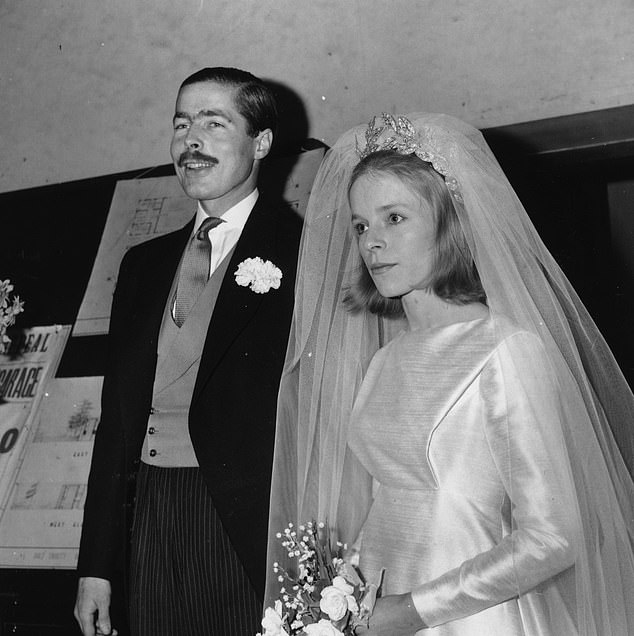
John Richard Bingham, Earl of Lucan, and Veronica Duncan after their marriage in 1963
A further visit was made to 46, Lower Belgrave Street on the afternoon of Saturday November 9, after reading Lady Lucan’s statement respecting the basement lighting. On examination of the fitting at the foot of these stairs, it was found that the bulb was missing. On a nearby chair was a 100-watt bulb which, when inserted into this light fitting, adequately lit these stairs.
In the account given to Mrs Maxwell-Scott by Lord Lucan he said he saw his wife being attacked by a man in the basement. This was refuted by his wife who said she was attacked on the ground floor at the head of the basement stairs. I called upon Miss Margaret Pereira, a foremost forensic expert, to examine the two areas of attack [See Forensic Evidence].
In the meantime, information had been received that Lord Lucan was in possession of a Ford car belonging to a woman living at 60, Elystan Place, London, SW1. Enquiries made at this address, revealed it was the address of Mr Michael Stoop, an old friend who had lent Lord Lucan his dark blue, Ford Corsair (KYN 135D), some two weeks previously. (Lord Lucan said his Mercedes was being repaired CHK). This vehicle, together with a description of Lord Lucan’s clothing was circulated to UK police forces.
The reader will recollect that Lord Lucan alleged to Mrs Maxwell-Scott, and his mother, that he had seen the events at 46, Lower Belgrave Street by looking through the basement kitchen window from the road or pavement outside. It was decided to test this theory: at about 10pm, that evening, I returned to the scene with two colleagues. Suffice to say when passing this address by car, the basement window is not visible due to cars parked in the street.
When the breakfast room light over the table was lit, it was not possible to see the foot of the stairs where the attack on Sandra Rivett took place. It was only when the kitchen lights and breakfast room light were switched on that it was possible to see the stairway to the extent of the third or fourth stair.
Miss Pereira visited the murder scene and arranged to return the following day with an artist to sketch the various directional blood splashes and carry out a full examination of the seats of attack.
The Ford Corsair loaned to Lord Lucan (by Michael Stoop), was found abandoned at Norman Road, Newhaven, Sussex on Sunday November 10, 1974, in the following circumstances:
Det Sgt Delima of the Sussex Constabulary contacted Gerald Road Police Station and at 5.15pm, that same day, I attended the scene with two colleagues. In the car boot, was a piece of lead piping, bound in adhesive tape, visually identical to the murder weapon found at Lower Belgrave Street. The vehicle and contents of the boot were photographed. Both the vehicle and the weapon were then removed by the Metropolitan Police Laboratory for examination.
On Monday November 11, 1974, Michael Stoop went to his club, the St James, and was handed a number of letters by the Porter, one of which was unstamped. He recognised Lord Lucan’s handwriting. In the note [Lord Lucan] briefly told him that he had had a ‘traumatic night of unbelievable coincidences’, details of which he had given to his brother-in-law. He stated he did not wish Stoop to get involved but asked that he would tell his children that he knew their father.
He mentioned that a crooked solicitor and a rotten psychiatrist destroyed him and that no-one would believe him as to what had happened. He finished the letter by saying ‘and I no longer care except that my children should be protected’. Unfortunately, Stoop did not hand [the letter] to police until the following day. The envelope could not be recovered.
At this stage, with the car found abandoned at Newhaven, it was thought that Lord Lucan might have fled the country. [By now] I appreciated he had many wealthy friends in various parts of the world who would be prepared to assist him. Therefore, on Tuesday November 12, 1974, following consultation with the Director of Public Prosecutions’ Office, I made a successful application to Mr E. Russell at Bow Street Magistrates’ Court, for warrants to arrest Lord Lucan for (1) the murder of Sandra Rivett and (2) the attempted murder of his wife, Lady Veronica Lucan.
INQUEST
At Westminster Coroner’s Court, Horseferry Road, London SW1, on November 13 1974, evidence of identification was given to the coroner, Dr Gavin Thurston, by the husband [of Sandra Rivett] Mr Roger Rivett, the cause of death by Prof Keith Simpson and the current position of the enquiry by myself.
It was adjourned until December 11 1974. It was subsequently adjourned until March 10 1975 when, it is expected, unless Lord Lucan is found, the inquiry into the death of Sandra Rivett, will be heard.
EVIDENCE OF RELEVANT WITNESSES
Lady Veronica Lucan will state that she has been in residence in Lower Belgrave Street since 1964. She also describes how she came to employ the Nanny, Sandra Rivett.
[Her full account of the night of November 7 1974 is recorded earlier].
Lady Lucan has been shown the U.S. mail bag that contained Sandra Rivett’s body. She is adamant she has never seen it before. Enquiries in America have failed to trace the origin of this sack.
Lady Frances Bingham describes watching television with her mother and how Sandra had left to make the tea. [After her mother left the room] she heard a scream but thought the cat had scratched her mother. Sometime later she can say how her mother and father entered the bedroom and can speak of the blood on her mother’s face and the fact that she was crying.
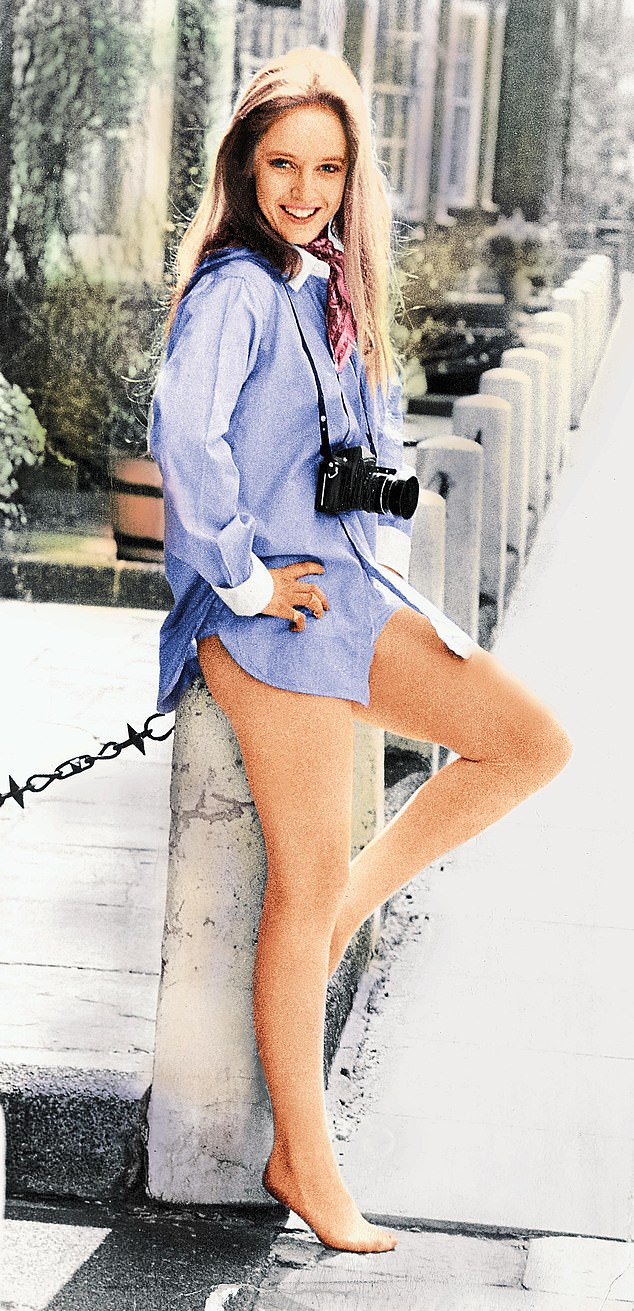
Society photographer Charlotte ‘Andrina’ Colquhoun was expecting to have dinner with Lord Lucan on the fateful night of November 7, but was unable to contact him
Frances [says] her mother told her to go upstairs to bed. Shortly afterwards she heard her father call, ‘Veronica, Veronica’, and on looking over the bannisters from the fourth floor, saw her father coming from the nursey on the third floor. This was the last time she saw him. Lady Frances is an extremely intelligent and truthful young lady.
Arthur Whitehouse, 43, head barman of the Plumbers Arms public house, describes Lady Lucan entering between 9.30pm and 9.50pm, her hysterical manner and head wounds. He telephoned for the emergency service.
Cevald Kolbjorn Olavsen, 47, a courier attached to the Norwegian Embassy, was in the Plumbers Arms. [He] elicited from Lady Lucan, her address. He went to 46, Lower Belgrave Street which he found in darkness except for the top floor which was lit.He tried the front door, which was closed, and remained at the scene until the arrival of the police.
In the meantime, the ambulance had arrived. Mr Frederick Strahan, a trainee ambulance supervisor, and Mr Martin Broom, ambulance man, will say they are employed by the London Ambulance Service and received a call at 9.57pm to proceed to 46, Lower Belgrave Street. They eventually went to the Plumbers Arms where they dressed Lady Lucan’s head injuries and removed her to St George’s Hospital, accompanied by PC Chapman.
The Dowager Lady Kaitlin Lucan: [Her account is recorded earlier]
In a further statement, the Dowager says she loaned her son £4,000 [£42,000 today] at the end of the High Court case in 1973.
Mrs Madelaine Florman, a housewife, 44, lives in Chester Square, SW1, 200 yards from 46, Lower Belgrave Street and will say that at about 10.30pm on November 7, she was awakened by the front doorbell. Her husband was away, and she did not answer the door but went back to sleep but was again woken, this time by the bedside telephone. She can give no indication of the time. When she answered a man said ‘Madelaine’… and she states there was an incoherent jumble of words, and she replaced the receiver. However, now she feels the caller was Lord Lucan.
On November 13 1974, six days after the murder, Mrs Florman noticed two dirty brown splashes on her white stone doorstep. She wrote of these marks to Dominic Elwes, a friend of Lord Lucan. It was whilst interviewing Elwes that this came to light. Swab samples were taken of what appeared to be a blood stain on her front door and the results will be discussed under ‘Forensic Evidence’.
Susan Maxwell-Scott, 38, a housewife and her husband, Ian, live in a detached country residence known as Grants Hill House, Uckfield, Sussex, and it was there, at about 11.30pm, on November 7 1974, that Lord Lucan went. Ian Maxwell-Scott had arranged to stay in London that night and his wife was alone with her children when the doorbell rang.
On looking out of the first-floor bathroom window, she could see Lord Lucan at the front door. She let him in. He related to her his version of the events that happened earlier that evening [See previous account].
It will also be remembered that he telephoned his mother from this address and wrote the two letters to William Shand-Kydd which he asked her to post. At about 1.15am on Friday November 8, Lord Lucan left Grants Hill House, giving the impression he was returning to London. Mrs Maxwell-Scott cannot be sure of the car he was driving but from her description it would appear to the Corsair.
As Mrs Maxwell-Scott was apparently the last person to see Lord Lucan alive, (coupled with the delay in reporting to the police the visit by Lord Lucan), I decided to reinterview her. I gained little or no further information but was of the opinion she was not telling the full story.
According to Mrs Maxwell-Scott, Lord Lucan was at her address for one-and three-quarter hours and it is felt that much more happened and was said during this time than this witness is prepared to disclose.
One ponders why Mrs Maxwell-Scott, a barrister, did not contact police or other close friends.
An indication of her reluctance to assist police came about whilst interviewing her husband on December 5 1974, when he volunteered the information that his wife had given Lord Lucan four Tuinal tablets [a barbiturate/sleeping pill] on November 8 1974. She [later] confirmed this was true, was sorry she had not remembered this, but refused to make a further statement covering this point.
This woman’s strange behaviour was again illustrated when, during the early hours of Monday January 26 1975, she contacted the Daily Mail newspaper alleging she had received a telephone call from Post Office Telegrams to the effect that Lord Lucan was safe and well. According to her the message which she wrote down went as follows: ‘TELL MOTHER ALL WENT AS PLANNED. I AM SAFE HERE. LOVE JOHN.’
This matter came to light through an article in the Daily Mail but Mrs Maxwell-Scott did not inform police until 12.50pm that day. When re-interviewed, she was of the opinion it was a cruel hoax.
Enquiries of the General Post Office failed to trace the telegram and I feel that this woman could well have made up this story to gain publicity for herself.
In my investigation, I have been led to believe Mrs Maxwell-Scott had an infatuation for Lord Lucan and this may well be the reason for her reluctance in telling the whole truth.
Mr William Shand-Kydd, 37, a company director of London, W2, and the brother-in-law of Lord Lucan, will say that on Saturday, November 9, 1974, he received two letters written by Lord Lucan and having been contacted by Ian Maxwell-Scott, handed these letters to police.
Michael Stoop, 52, retired, of London SW3, speaks of his friendship with Lord Lucan and of lending him the Ford Corsair motor car, KYN 135D, on October 21 or 23, 1974.
He will also say that when he loaned the car to Lord Lucan it did not contain any lead piping.
FORENSIC EVIDENCE
Ian Lucas, a Senior Fingerprint Officer of the Fingerprint Branch at New Scotland Yard, examined the murder scene, Lord Lucan’s flat at, Elizabeth Street, [Lucan’s] Mercedes, the Ford Corsair, the letter addressed to Stoop, the murder weapon and the similar instrument found in the Corsair. The only relevant evidence is that a finger mark found in the Corsair matches one found at 72A, Elizabeth Street. However, this mark could not be conclusively proved without a full set of Lord Lucan’s fingerprints.
Miss Margaret Pereira, a Principal Scientific Officer from the Laboratory, made a detailed examination of the blood marks at the murder scene. She will say, broadly speaking, that blood found in the basement was Group B and belonged to Sandra Rivett, and blood found in the bedroom, ground floor and the upper steps of the basement, was Group A and belonged to Lady Lucan.
Miss Pereira found traces of Lady Lucan’s hair in the ground floor cloakroom hand basin, in blood adhering to the paintwork at the head of the basement stairs, on the murder weapon and inside the Ford Corsair.
Miss Pereira will say the Elastoplast type tape covering [the murder weapon] was blood stained and reacted to Group A and B, which could have been the result of the mixture of Sandra Rivett’s and Lady Lucan’s blood.
In addition to the Ford Corsair, Lady Lucan’s hair, contained blood of both Group A and B and also AB which again could have been a mixture of both victims’ blood.
The witness Mrs Florman discovered what appeared to be blood on her front doorstep and swabs were taken. Miss Pereira will say on one she found blood which reacted to Group B – Sandra Rivett.
The two letters handed to police on November 9, 1974, by Mr Shand-Kydd, bore faint traces of blood. These were reacted to Group AB, a mixture of two women’s blood.
At an early stage in this investigation, I believed that this was a premeditated crime: Lord Lucan planned to murder his wife on the evening he understood the Nanny would be away from the house. Unfortunately, Sandra Rivett had changed her day off, was present and mistakenly murdered. The attempt on Lady Lucan’s life followed.
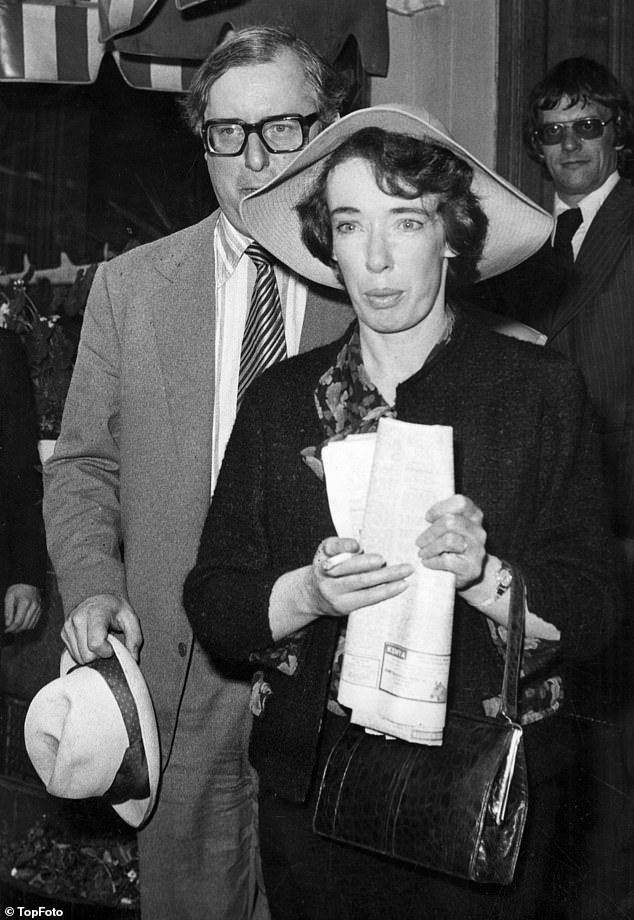
Susan Maxwell-Scott – pictured with husband William – was the last person to see Lord Lucan
EVIDENCE AND FACTS TO SUPPORT THE THEORY THIS WAS A PREMEDITATED MURDER
To understand any theory of premeditation, we must return to the period after the birth of the third child when the Lucan marriage began to founder, and which came to a head in January 1973 when Lord Lucan left the family home.
Christina Muriel Shand-Kydd, a housewife, 35, of London W2, the sister of Lady Lucan, can describe her relationship with her sister, [her] knowledge of the marriage and… of her sister’s alleged mental instability, the subsequent break-up of the marriage and the fact she gave evidence for Lord Lucan at the High Court custody hearings.
The Hon Hugh Bingham, 35, an unemployed Scientific Editor of London SW5, the younger brother of Lord Lucan, speaks of his family ties and comments on Lady Lucan’s supposed mental state.
Charles Benson, 39, a journalist, of London SW1, was with Lord Lucan at Eton and… is most probably one of his closest friends. He can speak of instances where [Lady Lucan’s] behaviour at social functions caused embarrassment, of Lord Lucan’s state of mind since the marriage break-up and the borrowing of [Lucan’s] Mercedes on November 6, 1974, which indicates that this vehicle was in good mechanical working order.
Stephen Raphael, 71, a stockbroker of London W2, was a father figure in whom Lord Lucan confided. He noticed an increase in his drinking for six months prior to the murder and had recently lent Lord Lucan £4,000 [£42,000 today] on an interest-free basis.
Dominic Elwes, 44, a landowner and painter of Cadiz, Spain, has known Lord Lucan for about the last ten years and saw a great deal of him at the Clermont Club. He was aware of the unhappy marital situation and mentions two important facts.
Firstly, an occasion around November 5, 1974, when he met Lord Lucan in Elizabeth Street in possession of a blue Ford car that appeared to be ‘just an old banger’, which Lord Lucan said he’d borrowed from a friend while his Mercedes was being repaired.
The second is he saw Lord Lucan on Wednesday November 6, 1974, in Annabel’s, the night club beneath the Clermont, when it was arranged that he should lunch with him and a Mr Meinertzhagen at the Clermont Club the following day.
Daniel Meinertzhagen, 32, a Company Director of London SW1, has known Lord and Lady Lucan for about ten years. He also speaks of the unusual behaviour of Lady Lucan at various social functions. This witness mentions that Lord Lucan had told him after the break-up of his marriage, he employed private detectives and would himself on occasions, go past 46, Lower Belgrave Street late at night to see what was going on in the house.
Mr Meinertzhagen saw Lord Lucan around October 25, 1974, feeding a parking meter in Eaton Square, on which there was a dark blue saloon. Lord Lucan said that he was looking after it for a friend. He then drove away in his own Mercedes which was parked nearby.
James Goldsmith, 42, a businessman, of London NW1, is another old friend of Lord Lucan. He mentions his financial distress, mainly because of the lawsuit over the children and says [Lucan] was trying to raise money from an American ‘auntie’ to pay off his wife as he thought she would be more interested in the money than the children.
He will also speak of Lord Lucan around December 1973 asking him for a loan of £10,000 (£53,000). Mr Goldsmith opened a deposit account at the Midland Bank for £5,000 for Lord Lucan. He says over the last 18 months Lord Lucan’s problems were affecting him and his drinking had increased.
Joseph Dwek, 35, of Independent Means, of London SW1, has known Lord Lucan for some years. They were both gamblers. He noticed Lord Lucan’s anxiety that [his] children were not being properly looked after. Lord Lucan once relayed to him taped telephone conversations of Lady Lucan’s hysteria on the telephone. Lord Lucan said he was collecting evidence against his wife for his custody battle.
Roger Gibbs, 40, a banker, of London SW10, attended Eton with Lord Lucan, was an usher at his wedding and friend of the couple. He mentions Lord Lucan discussing piling up evidence for a second attempt to obtain custody of the children. His financial problems were causing him some concern.
Alexander Ingleby-McKenzie, 41, an insurance broker, of London W1, attended Eton with Lord Lucan and comments on Lady Lucan’s behaviour and the disparity between her and her husband. Since losing custody Lord Lucan [was] drinking more and had more gambling losses. Mr Ingleby-McKenzie will say Lucan was suffering mentally and inwardly in an introverted manner.
Richard Parkes, 43, a company director, of London SW3, gambled and played golf with Lord Lucan. In September 1974, Mr Parkes stood guarantor, for Lord Lucan to borrow the sum of £3,000 (£32,000), from the Edgware Trust, a well-known firm of money lenders to the aristocracy (interest 48% pa).
Charles Genes, 68 of Bexleyheath, Kent, is the Company Director of the Edgware Trust Ltd and a licensed money lender. Mr Genese can say on September 11, 1974, Lord Lucan requested a loan of up to £5,000 (£53,000), stating his income was about £12,000 (£127,000) pa gross but his outgoings were greater. The loan would be repaid from the proceeds of selling some family silver.
Selim Zilkha, 47, Chairman of Mothercare, of London W1, will say he has known Lord [and Lady] Lucan for approximately 12 years. On October 8, 1974, Lord Lucan asked for a loan of £5,000 [£53,000]. Zilkha gave him a cheque for £3,000. Lord Lucan gave him a post-dated cheque for this amount. Lord Lucan attended a dinner party at Zilkha’s home on November 6, 1974, and his behaviour was ‘normal’.
Lady Frances Bingham, 10, the daughter of Lord and Lady Lucan, will say that she spent the weekend prior to the murder with her father. He enquired then when the Nanny, Sandra Rivett, had her days off and she volunteered the information it was on Thursdays.
Greville Howard, 34, a banker, of 5, Eaton Row, London SW1, has been a friend of Lord and Lady Lucan’s for about the last seven years and is a regular the Clermont Club and Annabel’s. He lives in the accommodation leased by Lord Lucan. He speaks of the unusual behaviour of Lady Lucan on various occasions. Sometime in 1974 he was having a drink with Lord Lucan, when his (Lord Lucan’s) financial affairs were being discussed.
Lord Lucan said how much easier it would be to get rid of his wife and [how] one could dump the body in the Solent and nobody would ever find it. When rebuked by Mr Howard, he replied: ‘I wouldn’t be caught.’
On another occasion in 1974, Lord Lucan showed [Howard] a bugging device which he planned to put into Lower Belgrave Street to record conversations for use as evidence against his wife in his custody battle. Mr Howard can also say that on Thursday, November 7, 1974, at around 5pm, he rang Lord Lucan at Elizabeth Street and invited him to the theatre that evening. Lord Lucan declined but suggested the witness (and his friends) join him for dinner afterwards at the Clermont Club. When Mr Howard and his party arrived between 10.45 and 11pm, there was no trace of Lord Lucan.
Michael Stoop, previously mentioned, has known Lord Lucan for the last 15 to 20 years. He will say that on October 21 or 23, 1974, Lord Lucan enquired if he [could borrow the Ford Corsair]. Stoop surmised it was because he did not want to be seen by Lady Lucan or her enquiry agents. However, the Prosecution will later suggest that the reason he wanted the car was, in fact, its nondescript appearance for the removal of his wife’s body from Lower Belgrave Street.
There is no evidence to suggest that Lord Lucan was a womaniser, but my enquiries reveal several women with whom he was friendly.
Caroline Hill, 37, a secretary, of London SW3, has been a friend of Lord Lucan since 1956 and taught him/his children the piano. He has sought Miss Hill’s advice about life with a mentally disturbed person (ie Lady Lucan). Lord Lucan was last seen by Miss Hill on November 6, 1974, between 11.30 and 12 noon, when, after his weekly piano lessons, he left in his Mercedes.
Charlotte Colqhoun (known as Andrina), 22, a photographer, of London SW3, lunched and dined with Lord Lucan several times a week. Their friendship was based on his interest in her photography, while she enjoyed the entrée he afforded her in London society. This witness can speak of Lord Lucan’s love for his children and of being his companion on November 6, 1974, at dinner. She will say on November 7, 1974, she rang him at Elizabeth Street when he was vague as to his movements that evening, suggesting they should have dinner but to confirm this in the afternoon. Miss Colqhoun will say that on the afternoon of the 7th, she phoned him without success.
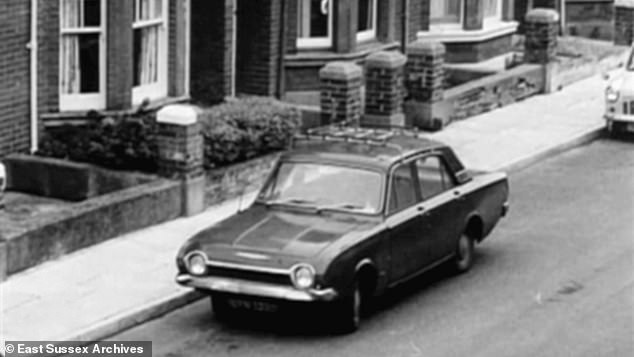
The Ford Corsair loaned to Lord Lucan which was found abandoned in Newhaven, Sussex
I make mention here of three other witnesses whose evidence I feel is important in the case for the theory of premeditation and a form of alibi on the night in question.
Michael Hicks-Beech, 33, a Literary Agent, of London SW3, is another gambling friend of Lord Lucan’s, and another witness who can speak of Lady Lucan’s alleged strange behaviour and Lord Lucan’s obsession with regaining custody of his children. At about 4.45pm, on Thursday, November 7, 1974, Lord Lucan telephoned this witness, asking him to edit an article on gambling. Mr Hicks-Beech arrived at Elizabeth Street sometime between 6.30 and 7pm.
[He heard] Lord Lucan call the Clermont Club and book a table for dinner that evening. Lord Lucan drove him home in a car which from the description was the Ford Corsair.
Andrew Demetriou, 45, of Shepperton, Middlesex, is the Assistant Restaurant Manager at the Clermont Club and will say that on November 7, 1974, at about 8pm, he received a call from Lord Lucan for the booking of the table for four as described above.
William Edgson, 31, a Link Man, of London N22, parks cars outside the Clermont Club. He is adamant that on Thursday, November 7, 1974, Lord Lucan arrived at about 9pm, and enquired who was present. On being informed Mr Howard and Mr Benson, by the witness, Lord Lucan replied he would be back and drove off. The important aspect of this witness is, firstly that [Lucan] drove off in his Mercedes and secondly the time factor which was just prior to the murder. The distance from the Clermont Club to Lower Belgrave Street is no more than a mile and by car can easily be reached in ten minutes.
FINANCIAL POSITION OF LORD LUCAN
Lord Lucan’s financial position is another aspect of premeditation and motive.
The income from his family trust was in the region of £7,000 (£74,000*) gross (£5,500 or £58,000* [after tax). It is suggested that his outgoings were far more (maintaining his family and himself in separate homes, and his extravagant living) and that he was heavily in debt.
One can only speculate on the total costs of the High Court action involving the children. Enquiries of the Official Solicitor reveal the Courts will amount to £4,000 (£42,000*) and it is not known if he paid his own costs which amount, I believe, to some £40,000 (£422,000*). Therefore, it is believed his general indebtedness is in the region of some £74,000 (£782,000*). However, it is only fair to point out that since his disappearance, a quantity of silver has been sold on his behalf at Christie’s which realised some £17,000 (£179,000*). In addition, he has several thousand pounds in banks in Rhodesia and Switzerland.
POINTS OF EVIDENCE TO SUPPORT THE THEORY OF PREMEDIATION
- The constant bickering between Lord and Lady Lucan which resulted in the break-up of the marriage and the struggle to gain possession of his children, brought about a tremendous change in his lifestyle and income.
- There is no doubt that there was a certain hatred between the couple, whereby Lord Lucan had a fixation that his children were not being brought up according to his wishes, by a woman who, although a Countess by marriage, was not a member of the aristocracy.
- The rent for 72A, Elizabeth Street amounted to £600 (£6,340) per quarter and therefore if he could dispose of his wife, he could give up his flat. The leases of the properties, namely 46, Lower Belgrave Street and 5, Eaton Row, are valued at a conservative estimate of £50,000 (£582,000) each. His entire debts would be [nearly] written off by the sale of one of these leases and that, plus the sale of the family silver, would leave him in credit. He would then be able to live comfortably off the proceeds of the family trust and, of course, have the custody of his children.

Sandra Rivett with her husband Roger before her tragic and brutal death
- He made it clear to his friends that he was in the habit of passing the family address in Lower Belgrave Street at all hours of the day and night to try and collate evidence of his wife’s movements and/or wrongdoings, and he continually mentioned her bizarre behaviour. Prior to the Court hearings, he had Lady Lucan examined by various psychiatrists to prove mental instability. This would appear to have back-fired at the custody hearings as their evidence was not accepted by the Court. It therefore left him with no alternative but to get rid of his wife, in some other way, it is suggested by murder.
- At least three months before the murder, he discussed his unstable financial state and suggested his only alternative was to kill his wife and dispose of her body in the Solent.
- His next step was to borrow an old car [the Ford Corsair} which would not be as noticeable as his reasonably new Mercedes.
- He ascertained from his daughter, Frances, that the Nanny’s night off was usually a Thursday.
- The preparation of the murder weapon which is identical in appearance to a similar weapon later found in the boot of the Corsair motor car.
- The obtaining of a U.S. canvas mail bag.
- His possession of a key to 46, Lower Belgrave Street.
- His formulation of an alibi for the evening of the murder. It is suggested [he did this] by asking Hicks-Beech at short notice to attend his flat at 72A, Elizabeth Street to edit an article, by booking a table for dinner at the Clermont Club, by telephone, in the presence of Hicks-Beech for that evening, and by appearing at the Clermont Club, driving his Mercedes – and to be seen there – only a short time prior to the murder.
To summarise, Lord Lucan at this stage had the motive, weapon, means of entry, transportation, and an alibi. The scene was set.
LIKELY SEQUENCE OF EVENTS
It is suggested that the likely sequence of events was to be as follows: He entered the house using his own key, carrying the murder weapon and the US mail bag.
Knowing the layout of the house and his wife’s habits, he went to the basement. He removed the light bulb from the fitting at the bottom of the stairs as he did not want his wife to recognise him and cause an outcry.
He hid by the side of the stairs armed with a murder weapon to await his wife whom he thought was alone in the house with the children. Despite his careful planning, things went wrong in as much as Sandra Rivett, due to a sore throat, changed her day off, thereby becoming an unfortunate victim.
It is suggested that had Lord Lucan been successful in killing his wife, he would have placed the body in the sack, and the sack in the boot of the Ford Corsair. After attending the dinner at the Clermont Club he would have returned to the scene, innocently taking some of his dinner guests past the address and fortuitously would have found something strange about 46, Lower Belgrave Street, for example, the house ablaze with light or the door open.
Finding some excuse to enter he would have found his wife missing and taken possession of the children. Subsequently, he would report her as a missing person to Police, disposing of the body at some convenient later stage. This is only one of many possible theories.
ASSOCIATES OF SANDRA RIVETT
It is anticipated that at any subsequent trial and/or inquest, the character of the dead girl will be attacked, and it may be suggested she is a lesbian, a prostitute or at the very least a woman of loose morals. It will be remembered that in letters Lord Lucan wrote to his brother-in-law, he made references to an intruder at 46, Lower Belgrave Street who escaped.
This fact has become widely known and during my interviews with his close friends, they are of an opinion the murder could have been committed by a jealous boyfriend or associate of the deceased. Therefore, enquiries have been made with the assistance of the dead girl’s diaries and address book, to trace all male and female friends for rebuttal purposes.
Miss Rosemary Jordan, 32, a Matron of Forest Junior School, Snaresbrook, Essex, has been a friend of Sandra Rivett for the past five years and was her confidante. These two would visit many public houses and dance halls where they ‘picked up’ or met men with whom they would form friendships, some of which would develop into sexual relationships. Enquiries were concentrated into tracing and checking the alibis of these men, including her estranged husband and the father of her son. [All had alibis]
I have no doubt in my mind that Sandra Rivett had no leanings towards lesbianism as from her diary it is clear she indulged in, and enjoyed, frequent, natural sexual intercourse.
KEY ASSOCIATES LEADING UP TO THE MURDER
Philip Scales, 26, a branch manager of Bintworth, Hampshire, met Sandra in August 1972, a relationship developed, and she became pregnant in December 1973. The pregnancy was legally terminated in April 1974 at Guy’s Hospital, London, and the relationship ended in June 1974.
In July 1974, she formed a sexual relationship with John Thompson, an electrician, of Wimbledon, SW19, which lasted for a short time until she went to work in London and met the next witness.
Ronald Pluckrose, 41, a milkman, of London, NW8, met Sandra Rivett in August 1974 when she worked in Dorset Square, Paddington, W2. He formed a sexual relationship with her which continued until just prior to the murder, [but had waned] as she had met another boyfriend.
John Hankins, 26, a relief public house manager, was Sandra’s boyfriend at the time of the murder. She met him in September 1974 when he worked at the Plumbers Arms. At the time, as I have stated, she was still seeing Ronald Pluckrose but the relationship with Mr Hankins had developed and according to him, marriage had been mentioned.
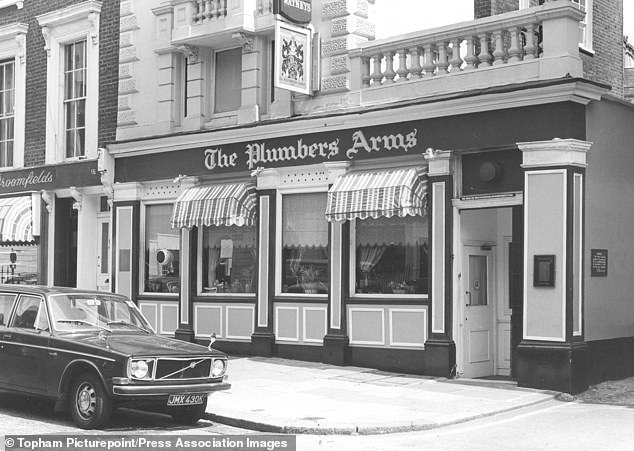
The Plumbers Arms, where Lady Lucan ran to after finding Sandra Rivett dead in her house
SIGHTINGS OF LORD LUCAN PRIOR TO THE MURDER
Persons who saw or spoke to him during this time have been dealt with elsewhere in the report. I make mention now of those witnesses not included previously.
Marguerite Jackson, 46, Headmistress of The Glendower School, London, SW7, was spoken to by Lord Lucan at 9.50am, on November 7, 1974, when he enquired if his daughter, Frances, was in school. Mrs Jackson could not verify this question and asked Lord Lucan if she could telephone him with the answer later. From Mrs Jackson’s enquiries she found that Frances was not at school that day and attempted to telephone Lord Lucan at 11am and again at 4pm but got no reply.
I consider this telephone call important as Lord Lucan could have inferred that as Frances was not at school, the Nanny would have been on a day off and his wife had failed to send her daughter to school.
Mr Alfred Simons, MPS, 45, a pharmacist, employed at John Harley Ltd (Chemist), of 6, Lower Belgrave Street, W1, can say that on November 7, 1974, Lord Lucan entered his shop at about 4pm, and showed him a capsule which Mr Simons identified as Limbutral [used to treat nervous complaints].
Lord Lucan had, on several occasions over the past two or three years, enquired of drugs – used by neurotic people – which he believed his wife was being prescribed. The source of this drug has not been established.
The investigation into the murder of Sandra Rivett and the attempted murder of Lady Lucan is still being carried out by officers. To date, more than 400 statements have been obtained [in the UK and abroad] and, of course, only a small portion are considered relevant.
In view of the very real possibility that Lord Lucan has committed suicide, it is likely that his body will be in such a state of decomposition that identification would be impossible. It was decided to trace his dental surgeon to assist in any further identification.
Enquiries reveal that Lord Lucan was treated by Mr Drummond Jackson of Wimpole Street, London, W1. His secretary, Margaret Hughes, can give evidence and produce dental charts and X-ray plates relating to Lord Lucan.
CONCLUSIONS
From my investigation into these crimes, I submit that there is clear evidence that Lord Lucan is the author.
I ask that this report, statements, documents, etc, be forwarded to the Director of Public Prosecutions, 4-12, Queen Anne’s Gate, London, SW1 for his information, with the request that he represent Police at the inquest on Sandra Rivett to be held at the Westminster Coroner’s Court, Horseferry Road, London, SW1, on March 10, 1975, before HM Coroner, Dr Gavin Thurston, and/or at any subsequent proceedings.
R.Ranson Detective Chief Superintendent ‘A’
NOW LISTEN TO THE TRIAL OF LORD LUCAN PODCAST
In a world-exclusive true crime podcast event, The Mail brings you The Trial Of Lord Lucan.
In episodes released daily from Monday 3 June to Friday 7 June, two real-life eminent barristers will argue whether Lord Lucan was innocent or guilty using the bombshell new document and unheard-of evidence in an unmissable twist on courtroom drama.
Follow the highs and lows of the case in forensic detail in the podcast, and then on Friday 7 we’ll ask YOU to act as a jury here on Mail Online in a fascinating public vote.
So will you clear Lucan… or not? Listen to the podcast and decide for yourself.
Listen to the podcast everywhere you usually get your podcasts.

